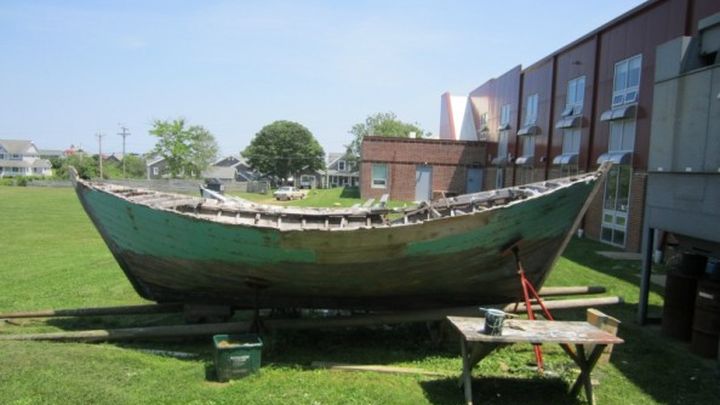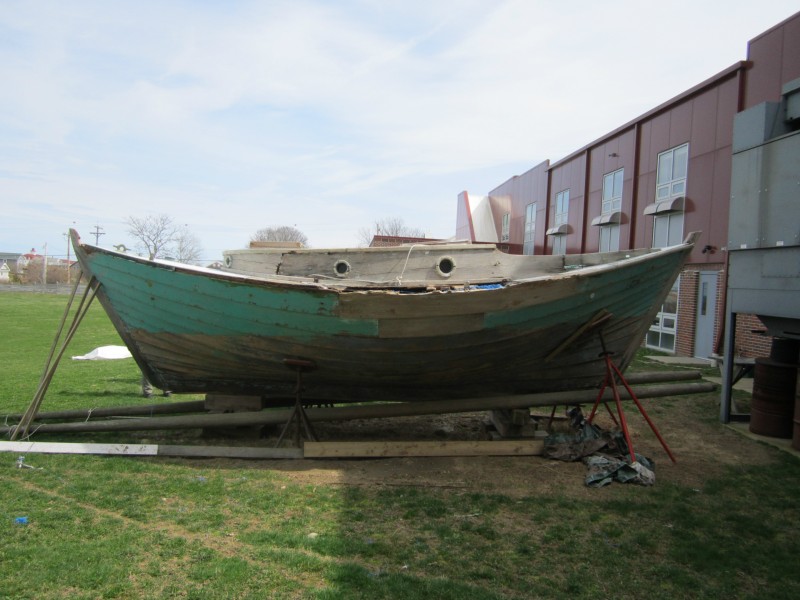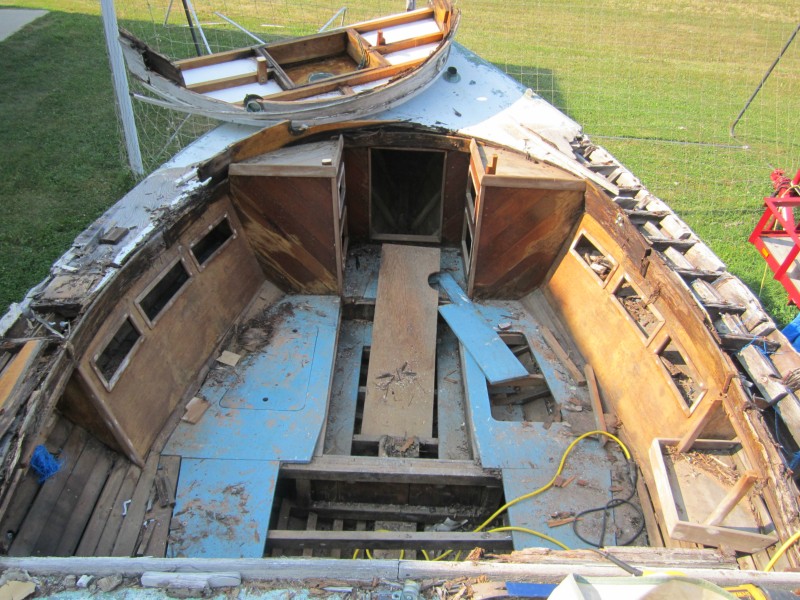
Restoration of "Unity"
The "Unity" is a Block Island Double Ender, which is a type of small open sailboat that was designed and used on Block Island from the early 1700's through the late 1800's. Its design allowed the early settlers of the island to fish offshore and run cargo to and from the mainland without the benefit of a harbor. The boats were light and strong so they could be pulled up on the beach, but they were also extremely seaworthy. Our mission is to restore "Unity" back to a historically accurate double ender. There are no surviving originals left and there are only a handful of replicas scattered around the country. The Historical Society would like to put on public display an accurate size replica of Block Islands only native craft on the island. With your help we can make that a reality.
In the summer of 2012 John Puckett began work on the "Unity"
as a volunteer internship which was part of the curriculum at the International Yacht Restoration School (IYRS) in Newport, RI. He has since graduated from the boatbuilding and restoration program at IYRS and would like to finish the work he has started. John started an individual page on gofundme.com to begin raising funds for the project. Recently a decision was made to start a charity page so that all the funding goes through the Block Island Historical Society, which owns the vessel. The total goal for the project is $10,000.00. The goal set here on this page is the remainder of the funds needed from the individual page.

The Vessel
The "Unity" was donated to the Block Island Historical Society in 2004. She was built in 1972 as a small coastal cruiser by a man named Ted Box. He used plans drawn by Howard Chapelle, a very well respected maritime historian. Chapelle took the lines for his plans off of one of the last original double enders on the island. His drawings included construction details which are of great value to this project. When Ted Box built the Unity he used these plans to build the hull, but modified the design by adding a cabin house, cockpit, and full decks. The result is that we have a boat in which the hull shape and construction methods are accurate to what an original double ender would have looked like. The fact that she was built with full decks and a cabin house is not.

Since "Unity" has been on the island her condition has gone from fair to poor. Wooden boats that sit on land for long periods of time do not usually fair well. The constant cycle of wet to dry and cold to hot has taken its toll. After years of shrinking and swelling her seams have opened, planks have split, and fasteners have failed. It would take a major rebuild to bring her back to a sailing condition. Last summer, a plan was hatched between John Puckett and the Historical Society to give her a new life as a land based display to be used for educational purposes. As an internship for IYRS which John graduated from in June. He volunteered to remove all of the parts and structures which were not historically accurate. Now that he is out of school we intend to finish the project by installing all the parts and structures that a double ender from the 1800's would have had. John has compiled a good amount of research and procured a copy of Howard Chapelle's plans from the Smithsonian Institute.



In addition to the new construction some modern materials, such as epoxy, will be used to keep the hull from rotting. This should ensure more longevity for the display of the vessel and require less maintenance for the future caretakers.
The Design
The history of the Block Island double ender is a bit hard to trace. The boats were built "by eye", which means there were no plans or drawings used in the construction. It also means that no two were exactly alike. Each boat was built to the specifications that the buyer requested. Sometimes a scale model was used and a few exist today. There are three models in the Historical Society's collection (two of which are on loan) and they each have a very different layout. The only set of accurate plans available was drawn by Howard Chapelle. He took the lines off an old wreck, rumored to be the last on the island, and drafted the plans. The 22 foot boat that he drew was a good representation of the most common size and layout used. The most typical sizes were between 18 and 28 feet. The largest vessel in the fleet was the "Island Belle", measuring 38 feet.
Generally the boats had a very substantial beam. This gave them a good amount of volume and stability when fully loaded. They had very little freeboard at midships, which means in the mid section of the boat the water line was not very far from the top edge of the hull. This made it easier to haul fish in over the side, but it also made it easer for water to spill into the boat in heavy weather. To reduce that risk they had removable boards that would increase the freeboard when needed. They were pointed at both ends (hence the name), and had a slightly higher bow than the stern. They had no outside ballast. They carried beach stones in the bilge which could easily be cast overboard or shifted in order to adjust the trim of the boat.
The rig was very hard to classify. There is much debate about what to call the rig. Rather then enter the debate we will just describe it. They carried two unstayed masts. One at midships, and one at the extreme forward end. The mast at midships usually carried more sail and had a long boom. The foremast had no boom and overlapped the mainmast. They had a very short gaff at the head of each sail, and both sails had many deep reef points. This unique rig allowed the sailors a wide variety of options for sail area in heavy weather. They were well known for their ability to go to windward in the strongest of gales. Over all the the design is considered to be one of the most seaworthy open boats ever built. In over 150 years of use there were only 2 recorded as lost. One struck a rock and sank off the mainland, and the other was reported as lost at sea. Possibly a victim of getting run down by a steamer in the fog. Not a bad track record for an open boat sailing in the one of the meanest parts of the coast all year long.
What is the money for?
Currently the Block Island Historical Society has $3,000.00 set aside for materials. Our estimates show that this should be more than enough to cover the lumber. We have in hand much of the painting supplies and other materials needed. The goal of $10,000.00 is what is estimated for labor cost. John estimates it will take 500 hours at $20.00 an hour. (If the boat was brought to a typical boatyard the labor cost would be more in the neighborhood of $60.00 to $80.00 per hour.) Any money received over the goal will be put in a dedicated savings account for future maintenance of the boat. The goal set on this page of $7,340.00 is the remaining money that needs to be raised after the initial fundraising push.
Accountability
The Board of Directors at the Block Island Historical Society will be overseeing the project. John has been and will continue to work closely with Pam Littlefield Gasner, the Executive Director, to ensure that the project is executed accurately and completely.
In the summer of 2012 John Puckett began work on the "Unity"
as a volunteer internship which was part of the curriculum at the International Yacht Restoration School (IYRS) in Newport, RI. He has since graduated from the boatbuilding and restoration program at IYRS and would like to finish the work he has started. John started an individual page on gofundme.com to begin raising funds for the project. Recently a decision was made to start a charity page so that all the funding goes through the Block Island Historical Society, which owns the vessel. The total goal for the project is $10,000.00. The goal set here on this page is the remainder of the funds needed from the individual page.

The Vessel
The "Unity" was donated to the Block Island Historical Society in 2004. She was built in 1972 as a small coastal cruiser by a man named Ted Box. He used plans drawn by Howard Chapelle, a very well respected maritime historian. Chapelle took the lines for his plans off of one of the last original double enders on the island. His drawings included construction details which are of great value to this project. When Ted Box built the Unity he used these plans to build the hull, but modified the design by adding a cabin house, cockpit, and full decks. The result is that we have a boat in which the hull shape and construction methods are accurate to what an original double ender would have looked like. The fact that she was built with full decks and a cabin house is not.

Since "Unity" has been on the island her condition has gone from fair to poor. Wooden boats that sit on land for long periods of time do not usually fair well. The constant cycle of wet to dry and cold to hot has taken its toll. After years of shrinking and swelling her seams have opened, planks have split, and fasteners have failed. It would take a major rebuild to bring her back to a sailing condition. Last summer, a plan was hatched between John Puckett and the Historical Society to give her a new life as a land based display to be used for educational purposes. As an internship for IYRS which John graduated from in June. He volunteered to remove all of the parts and structures which were not historically accurate. Now that he is out of school we intend to finish the project by installing all the parts and structures that a double ender from the 1800's would have had. John has compiled a good amount of research and procured a copy of Howard Chapelle's plans from the Smithsonian Institute.



In addition to the new construction some modern materials, such as epoxy, will be used to keep the hull from rotting. This should ensure more longevity for the display of the vessel and require less maintenance for the future caretakers.
The Design
The history of the Block Island double ender is a bit hard to trace. The boats were built "by eye", which means there were no plans or drawings used in the construction. It also means that no two were exactly alike. Each boat was built to the specifications that the buyer requested. Sometimes a scale model was used and a few exist today. There are three models in the Historical Society's collection (two of which are on loan) and they each have a very different layout. The only set of accurate plans available was drawn by Howard Chapelle. He took the lines off an old wreck, rumored to be the last on the island, and drafted the plans. The 22 foot boat that he drew was a good representation of the most common size and layout used. The most typical sizes were between 18 and 28 feet. The largest vessel in the fleet was the "Island Belle", measuring 38 feet.
Generally the boats had a very substantial beam. This gave them a good amount of volume and stability when fully loaded. They had very little freeboard at midships, which means in the mid section of the boat the water line was not very far from the top edge of the hull. This made it easier to haul fish in over the side, but it also made it easer for water to spill into the boat in heavy weather. To reduce that risk they had removable boards that would increase the freeboard when needed. They were pointed at both ends (hence the name), and had a slightly higher bow than the stern. They had no outside ballast. They carried beach stones in the bilge which could easily be cast overboard or shifted in order to adjust the trim of the boat.
The rig was very hard to classify. There is much debate about what to call the rig. Rather then enter the debate we will just describe it. They carried two unstayed masts. One at midships, and one at the extreme forward end. The mast at midships usually carried more sail and had a long boom. The foremast had no boom and overlapped the mainmast. They had a very short gaff at the head of each sail, and both sails had many deep reef points. This unique rig allowed the sailors a wide variety of options for sail area in heavy weather. They were well known for their ability to go to windward in the strongest of gales. Over all the the design is considered to be one of the most seaworthy open boats ever built. In over 150 years of use there were only 2 recorded as lost. One struck a rock and sank off the mainland, and the other was reported as lost at sea. Possibly a victim of getting run down by a steamer in the fog. Not a bad track record for an open boat sailing in the one of the meanest parts of the coast all year long.
What is the money for?
Currently the Block Island Historical Society has $3,000.00 set aside for materials. Our estimates show that this should be more than enough to cover the lumber. We have in hand much of the painting supplies and other materials needed. The goal of $10,000.00 is what is estimated for labor cost. John estimates it will take 500 hours at $20.00 an hour. (If the boat was brought to a typical boatyard the labor cost would be more in the neighborhood of $60.00 to $80.00 per hour.) Any money received over the goal will be put in a dedicated savings account for future maintenance of the boat. The goal set on this page of $7,340.00 is the remaining money that needs to be raised after the initial fundraising push.
Accountability
The Board of Directors at the Block Island Historical Society will be overseeing the project. John has been and will continue to work closely with Pam Littlefield Gasner, the Executive Director, to ensure that the project is executed accurately and completely.
Organizer
john puckett
Organizer
New Shoreham, RI
Block Island Historical Society
Beneficiary